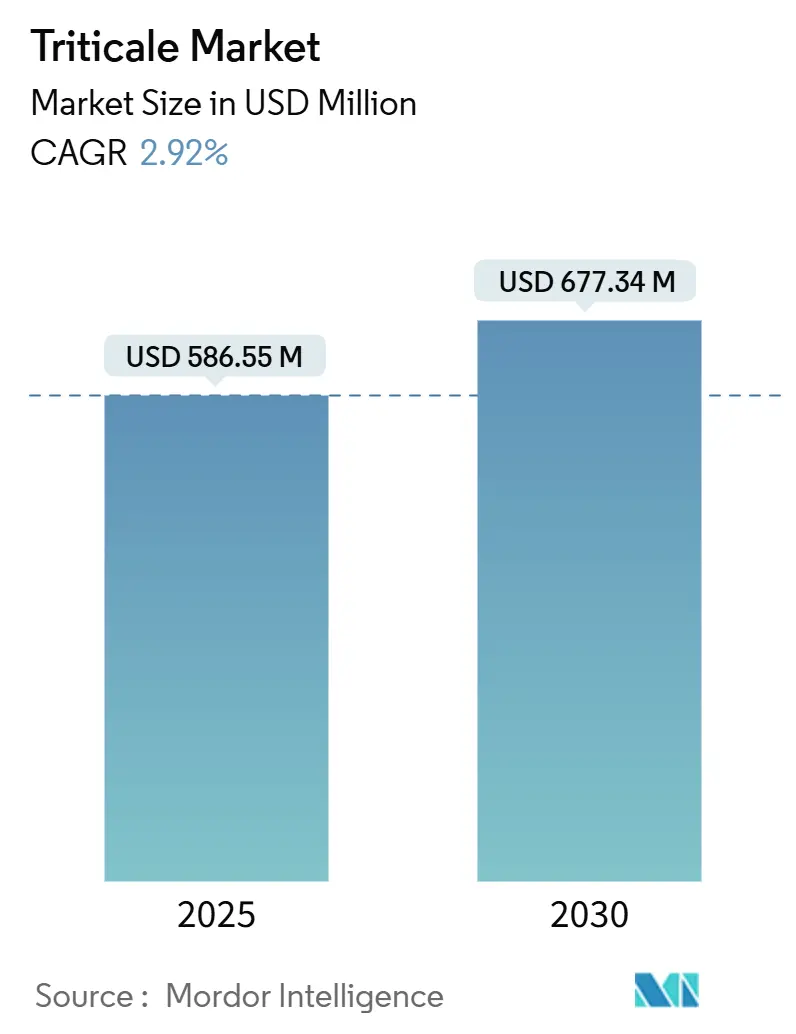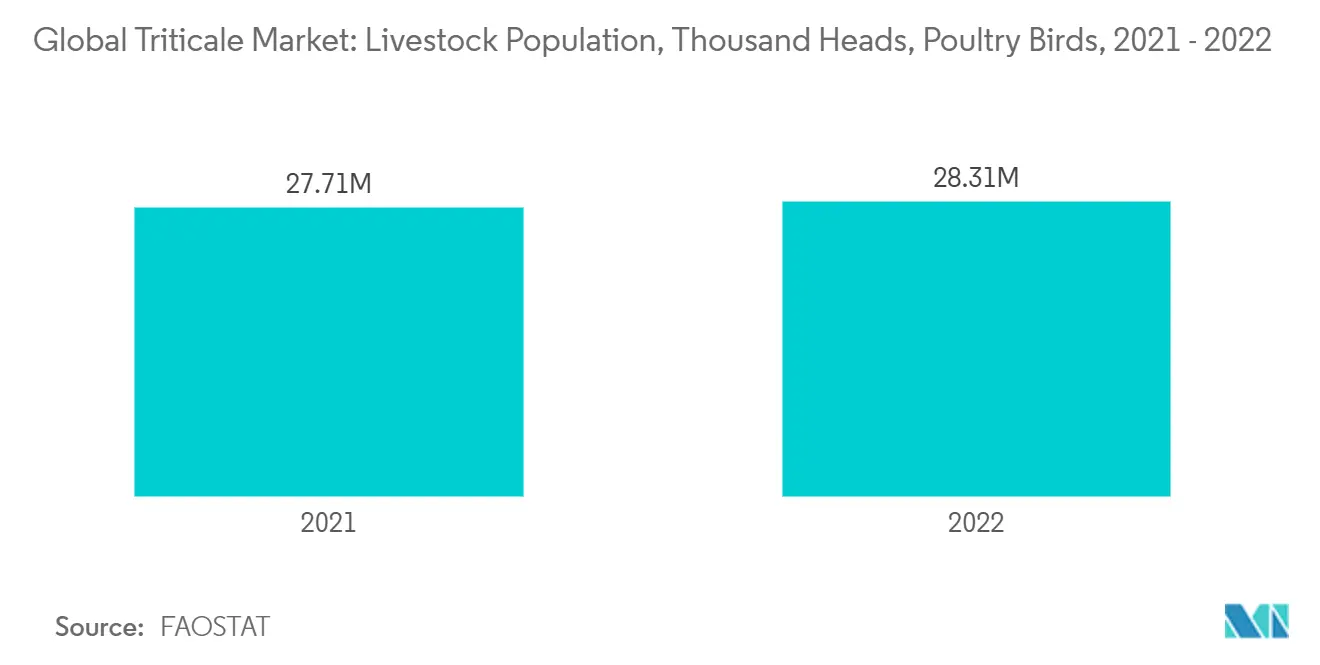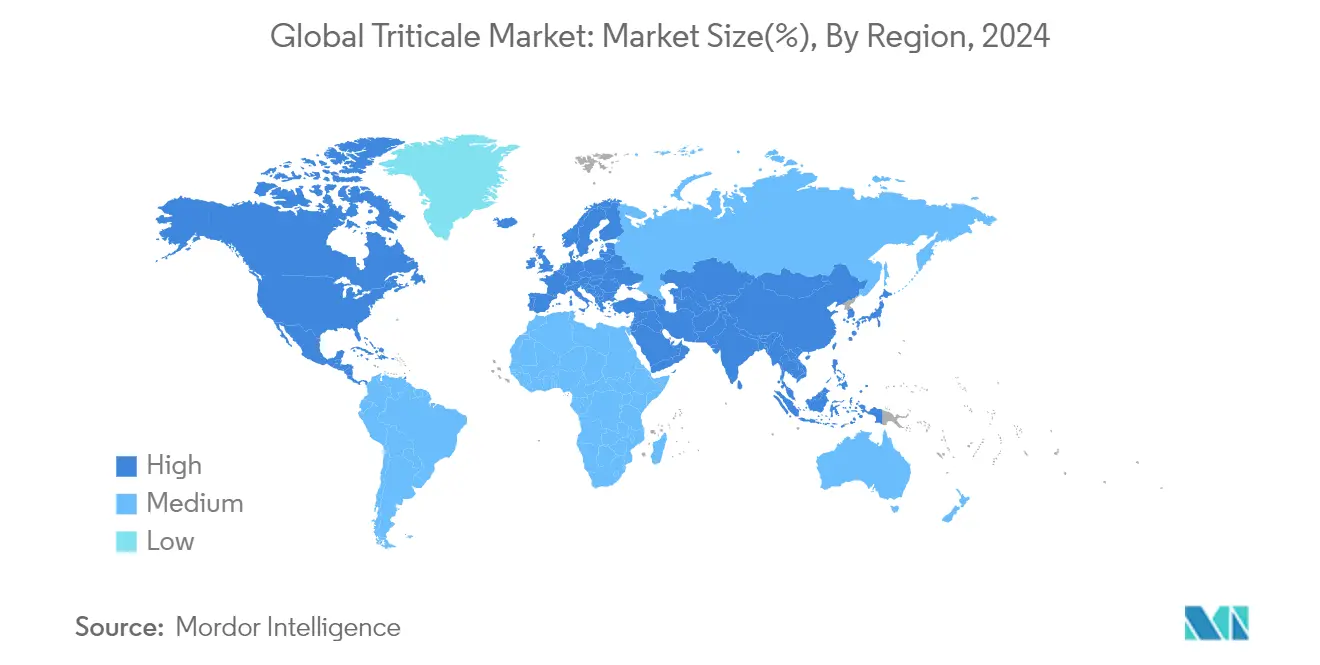Triticale Market Size and Share

Triticale Market Analysis by Mordor Intelligence
The Triticale Market size is estimated at USD 586.55 million in 2025, and is expected to reach USD 677.34 million by 2030, at a CAGR of 2.92% during the forecast period (2025-2030).
Triticale is gaining popularity among livestock growers globally due to its suitability for animal feed. The crop exhibits digestibility and water-soluble sugar content comparable to oats and cereal rye. Furthermore, triticale's ability to thrive in drought conditions and low-fertile soil attracts forage and livestock growers, contributing significantly to the global triticale market growth.
Poland and Germany dominate the global triticale production, having developed varieties that hold a significant position in the feed industry. According to FAOSTAT, Poland's triticale production reached 5.44 million metric tons in 2022, an increase from 5.34 million metric tons in the previous year. Despite the crop's general disease resistance, challenges persist with snow mold and septoria infections, prompting continuous breeding efforts to develop more resistant varieties. The escalation of conflict between Russia and Ukraine has emerged as a primary factor affecting the spring wheat and grain markets. This geopolitical situation is anticipated to influence market dynamics and prices during the forecast period.
Global Triticale Market Trends and Insights
Increasing use of triticale in Animal Feed
Triticale has gained increasing adoption in animal feed production, serving as an effective substitute for oats and cereal rye. In 2023, Texas A&M AgriLife developed a new triticale variety, TX14VT70526, which will be marketed as 'Titan' by Watley Seed.
Research conducted across Florida, North Dakota, and Canada demonstrated that finisher pigs fed with triticale showed comparable performance to those fed with corn. The cost advantage of triticale over corn positions it as an attractive option for livestock producers. The global poultry population reached 28,310,155 animals in 2022, marking a 2.15% increase from the previous year, according to FAO. This growth indicates expanded opportunities for North American triticale in the animal feed market.
Triticale yields higher forage output compared to other cereal grains. When combined with grain legumes, triticale increases the protein content of vegetative biomass. The use of winter triticale varieties for livestock grazing in Canada and the United States further supports market growth potential.

Europe is the Major Producer of Triticale
Poland maintains its position as the world's largest producer of triticale, contributing one-third of global production and over 40% of the European output. The country's production structure share has significantly expanded to 55%, demonstrating its growing dominance in the triticale market. The dynamics of Polish cereal consumption are fundamentally shaped by fluctuations in animal population and grain requirements for sowing. These agricultural inputs serve multiple industrial sectors, including feed production, biofuel manufacturing, and processing. The interplay of these factors is anticipated to drive sustained market growth throughout the forecast period.
According to the Food and Agriculture Organization of the United Nations (FAO), Poland, Germany, and France collectively represented 63.47% of global triticale production in 2023. In France, triticale has established itself as the second most cultivated cereal after wheat, highlighting its agricultural importance. The crop's cultivation area encompasses 326.3 thousand hectares in 2023, showing a marginal decrease from the previous year's 339.7 thousand hectares while maintaining a substantial 19% share. Within Poland's agricultural landscape, more than 50% of triticale cultivation is strategically concentrated in four key regions: Wielkopolskie, Mazowieckie, Łódzkie, and Lubelskie Voivodeships.

Recent Industry Developments
- October 2022: T101 Wintermax, a New Zealand-bred winter-active triticale variety introduced in the UK, offers spring grazing, April silage, and late June whole crop options. Field trials show higher yields than forage rye when planted mid-September to mid-October for optimal spring production.
- October 2022: The advancement of bread baking technique through cutting-edge additives that improve bakery goods made with triticale flour and give them therapeutic properties, using the raw material supply of the Russian Federation's bakery sector getting high-demand and popularity grain crop on the world market.
Global Triticale Market Report Scope
Triticale, a hybrid cereal derived from wheat and rye, serves multiple purposes, including human consumption, animal feed, forage production, and cover cropping. The global triticale market analysis encompasses geographical segments across North America, Europe, and Asia-Pacific regions. The market assessment includes a detailed examination of production volumes, consumption patterns (both value and volume), export-import dynamics (value and volume), and price trends. The report provides market size evaluations and forecasts measured in value (USD) and volume (metric tons).
| United States | Production Analysis (Volume) |
| Consumption Analysis (Volume and Value) | |
| Import Analysis (Volume and Value) | |
| Export Analysis (Volume and Value) | |
| Price Trend Analysis | |
| Canada | Production Analysis (Volume) |
| Consumption Analysis (Volume and Value) | |
| Import Analysis (Volume and Value) | |
| Export Analysis (Volume and Value) | |
| Price Trend Analysis |
| Poland | Production Analysis (Volume) |
| Consumption Analysis (Volume and Value) | |
| Import Analysis (Volume and Value) | |
| Export Analysis (Volume and Value) | |
| Price Trend Analysis | |
| Germany | Production Analysis (Volume) |
| Consumption Analysis (Volume and Value) | |
| Import Analysis (Volume and Value) | |
| Export Analysis (Volume and Value) | |
| Price Trend Analysis | |
| France | Production Analysis (Volume) |
| Consumption Analysis (Volume and Value) | |
| Import Analysis (Volume and Value) | |
| Export Analysis (Volume and Value) | |
| Price Trend Analysis | |
| Netherlands | Production Analysis (Volume) |
| Consumption Analysis (Volume and Value) | |
| Import Analysis (Volume and Value) | |
| Export Analysis (Volume and Value) | |
| Price Trend Analysis |
| China | Production Analysis (Volume) |
| Consumption Analysis (Volume and Value) | |
| Import Analysis (Volume and Value) | |
| Export Analysis (Volume and Value) | |
| Price Trend Analysis | |
| Australia | Production Analysis (Volume) |
| Consumption Analysis (Volume and Value) | |
| Import Analysis (Volume and Value) | |
| Export Analysis (Volume and Value) | |
| Price Trend Analysis |
| North America | United States | Production Analysis (Volume) |
| Consumption Analysis (Volume and Value) | ||
| Import Analysis (Volume and Value) | ||
| Export Analysis (Volume and Value) | ||
| Price Trend Analysis | ||
| Canada | Production Analysis (Volume) | |
| Consumption Analysis (Volume and Value) | ||
| Import Analysis (Volume and Value) | ||
| Export Analysis (Volume and Value) | ||
| Price Trend Analysis | ||
| Europe | Poland | Production Analysis (Volume) |
| Consumption Analysis (Volume and Value) | ||
| Import Analysis (Volume and Value) | ||
| Export Analysis (Volume and Value) | ||
| Price Trend Analysis | ||
| Germany | Production Analysis (Volume) | |
| Consumption Analysis (Volume and Value) | ||
| Import Analysis (Volume and Value) | ||
| Export Analysis (Volume and Value) | ||
| Price Trend Analysis | ||
| France | Production Analysis (Volume) | |
| Consumption Analysis (Volume and Value) | ||
| Import Analysis (Volume and Value) | ||
| Export Analysis (Volume and Value) | ||
| Price Trend Analysis | ||
| Netherlands | Production Analysis (Volume) | |
| Consumption Analysis (Volume and Value) | ||
| Import Analysis (Volume and Value) | ||
| Export Analysis (Volume and Value) | ||
| Price Trend Analysis | ||
| Asia-Pacific | China | Production Analysis (Volume) |
| Consumption Analysis (Volume and Value) | ||
| Import Analysis (Volume and Value) | ||
| Export Analysis (Volume and Value) | ||
| Price Trend Analysis | ||
| Australia | Production Analysis (Volume) | |
| Consumption Analysis (Volume and Value) | ||
| Import Analysis (Volume and Value) | ||
| Export Analysis (Volume and Value) | ||
| Price Trend Analysis | ||
Key Questions Answered in the Report
How big is the Triticale Market?
The Triticale Market size is expected to reach USD 586.55 million in 2025 and grow at a CAGR of 2.92% to reach USD 677.34 million by 2030.
What is the current Triticale Market size?
In 2025, the Triticale Market size is expected to reach USD 586.55 million.
Which is the fastest growing region in Triticale Market?
North America is estimated to grow at the highest CAGR over the forecast period (2025-2030).
Which region has the biggest share in Triticale Market?
In 2025, the Europe accounts for the largest market share in Triticale Market.
What years does this Triticale Market cover, and what was the market size in 2024?
In 2024, the Triticale Market size was estimated at USD 569.42 million. The report covers the Triticale Market historical market size for years: 2019, 2020, 2021, 2022, 2023 and 2024. The report also forecasts the Triticale Market size for years: 2025, 2026, 2027, 2028, 2029 and 2030.
Page last updated on:
Triticale Market Report
Statistics for the 2025 Triticale market share, size and revenue growth rate, created by Mordor Intelligence™ Industry Reports. Triticale analysis includes a market forecast outlook for 2025 to 2030 and historical overview. Get a sample of this industry analysis as a free report PDF download.

